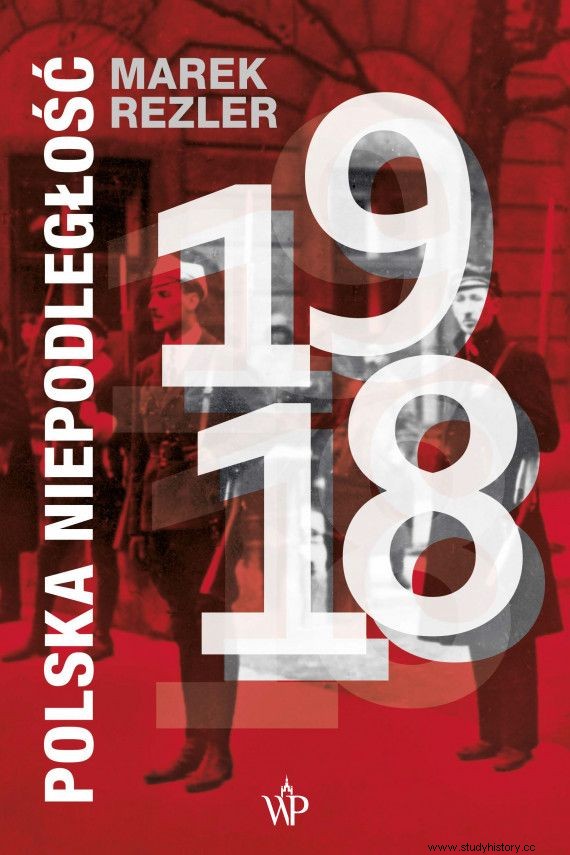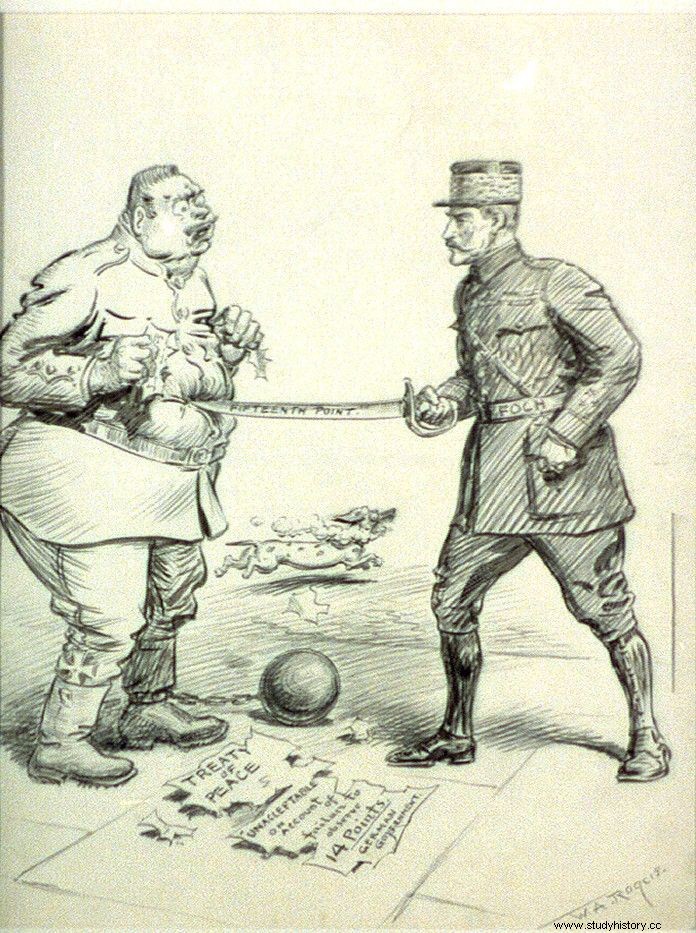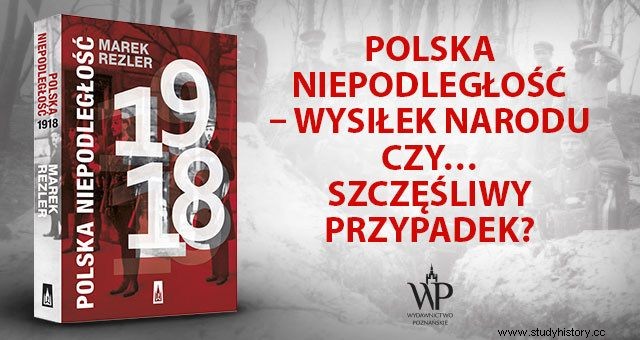The dedication of the Commonwealth of a large part of Wielkopolska was an exceptionally bitter pill for the Germans. They did not want to come to terms with the new shape of their eastern border for a long time. And it was close to sparking another partition of the Republic of Poland.
It is often forgotten that in November 1918 Poland reborn within severely truncated territorial borders. At that time, the lands of the Second Polish Republic were limited only to a part of the former Russian and Austrian partitions. But regaining independence caused a strong response also in other lands inhabited by Poles. As early as December 1918, an uprising broke out in the part of the Prussian partition.
The Germans, of course, immediately launched a counterattack, but their military plans towards Poles were not limited only to the suppression of the Greater Poland rebellion. One of the seriously considered scenarios at that time was ... the invasion of the lands of the Second Polish Republic! It could lead to the annihilation of Polish freedom at its inception.
War (un) positional
The Greater Poland Uprising ended the truce in Trier, concluded on February 16, 1919. Under pressure from the Entente countries, the Germans were forced to compromise. Among other things, they were ordered to stop acting against the Poles. A demarcation line was also established, which later, under the provisions of the Treaty of Versailles, became, with minor changes, the Polish-German border.

The Greater Poland Uprising ended with the truce in Trier of February 16, 1919. Had it not been for the tough stance of the Entente countries, history could have turned out quite differently. The photo shows the insurgents in the trenches.
The western neighbor was not going to give up easily, however. At the beginning of March 1919, a military concept aimed at Poland emerged. It was called the Stellungskrieg, or trench warfare. This term turned out to be quite confusing, because the plan was to launch a powerful offensive from the north and south. Its aim was to regain Wielkopolska and "break" it from the grip of the Second Polish Republic.
The fact that hostile actions were not taken resulted from the difficult internal and international situation in Germany. After all, the country barely lost the "great war", and negotiations on a peace treaty were still ongoing. In addition, the country was mired in a revolution that wiped out the empire and established a republic . No wonder the Stellungskrieg was abandoned after a month.
Spring sun
This did not mean, however, that the former invader accepted the terms of the Trier truce and the loss of Greater Poland. Until the conclusion of the peace treaty in Versailles in June 1919, the terms of the agreement were violated many times, violating the established demarcation line and taking offensive steps towards Poles.

Soon, further plans of military aggression against Poland appeared. They were undertaken after May 7, 1919, when the Germans got acquainted with the draft peace treaty. It was extremely hard on them and meant great territorial losses. The reaction to him was shock mixed with indignation.
When preparing the attack, it was hoped that an effectively conducted campaign would act as a show of strength and would be a bargaining chip in further negotiations with the Entente. The operation was given the name Frühlingssonne, meaning "Spring Sun". As Marek Rezler writes in the book "Polish independence 1918" , it was planned to "strike, led out of West Pomerania, Silesia and East Prussia, concentrically directed towards Warsaw". It was therefore not only about the recovery of Greater Poland, but also an extremely wide frontal attack on the entire territory of the Second Polish Republic . It would mean an open Polish-German war.
Meanwhile, on the Vistula River, only Józef Piłsudski was aware of the German threat. Most politicians and military men feared - and rightly so - the invasion from the east (which, by the way, took place). They were less concerned with the state of the borders in the west, even if, as pointed out by the Governor, there were still troops of the enemy army within the borders of Poland.

The conditions that the Entente imposed on the Germans were a real humiliation for the latter. Pictured here is a caricature by William Allen Rogers.
The danger seemed all the more real as the Germans lost the World War, but achieved a military victory on the Eastern Front. It could be an effective way of frustrating the ranks of their army, thereby increasing the risk of vengeance against their more advantageous rivals.
On the wave of growing fears of aggression from beyond the western border, on February 5, 1919, the so-called Białystok Agreement was concluded. It regulated the issue of the departure of German troops from Poland. Unfortunately, many soldiers did not intend to submit to the demobilization order at all. Some of them simply feared for their fate in the revolted country. Soon they started setting up a voluntary unit, the Freikorps. There were as many as 146 units of this type. The Poles began to realize that they could provide great support for the enemy during the attack.
Spring sun in June?
The tension between the neighbors grew with each passing day. It reached its apogee in June 1919. With the end of peace negotiations approaching, many German parties then began to press for the implementation of the "Spring Sun" plan.

In the spring of 1919, hundreds of thousands of German soldiers served in the Freikorps. In the photo, Minister Gustav Noske is visiting one of them.
It even happened that On June 22, 1919, German planes appeared in the sky over Częstochowa. A day later, minor local border fights began. However, they quickly expired, and the Germans humbly accepted the terms of the Treaty of Versailles and accepted their new eastern borders.
The war did not break out, so we can only speculate on how such a conflict would end. Would this be the end of the recently acquired independence? Marek Rezler in his book "Polish Independence 1918" presents an extremely gloomy scenario:
The Polish Army at that time was too weak to stop the invasion. The war would certainly be a loser (...) The experience of the following years allows us to state that it would be the final end to the hope of maintaining the independent Polish state.

There are military arguments in favor of his diagnosis. Our amia could only use 17 infantry divisions and 5 cavalry brigades to defend the western border. At that time, the Germans, on the very border of Greater Poland, had 14 divisional unions and 3 regional divisions at their disposal. Of course, the Poles could transfer some of the troops from the Eastern Front to this territory, but this, in turn, would weaken our chances against Russia. And it is not certain that it would have the expected results in the confrontation with Germany.
French hero
If the balance of power was so unfavorable for the Republic of Poland, why was the "Spring Sun" finally abandoned? The French, especially Marshal Ferdinand Foch, played a great part in defending Poland's interests. The plans of German aggression reached his staff and provoked a sharp response from the Entente countries.
Berlin was given an ultimatum in which it was threatened that in the event of an attack on Poland, allied troops would enter Germany. This direct threat effectively stopped their territorial aspirations.

The role of Marshal Foch in frustrating the German plan to attack Poland in 1919 could not be overestimated.
Thus, Marshal Foch played an invaluable role in this difficult moment. The brave French went down in history as a great friend of the country on the Vistula River. After a few years, in recognition of his contribution to our independence, he was even awarded the title of the Marshal of Poland.
History, however, can be brutally perverse, as Rezler notes in Polish Independence 1918. The German side postponed its plans for only twenty years. After this time, the idea of \ u200b \ u200battacking the Polish state was realized. And Foch's successors no longer showed the same strength of political pressure or determination as their predecessor in 1919.
Buy the book at a discount on empik.com

